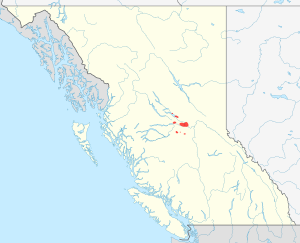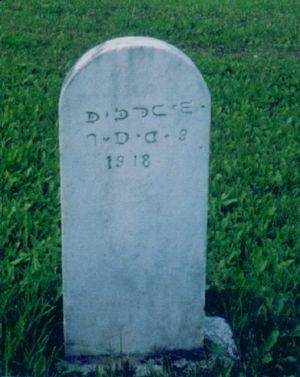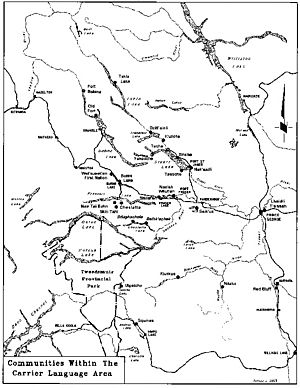Carrier language facts for kids
Quick facts for kids Dakelh |
||||
|---|---|---|---|---|
| Carrier ᑕᗸᒡ |
||||
| Native to | Canada | |||
| Region | Central Interior of British Columbia | |||
| Ethnicity | 9,350 Carrier people (2014, FPCC) | |||
| Native speakers | 1,270 (2016 census) | |||
| Language family | ||||
| Dialects |
Nak'albun/Dzinghubun
|
|||
| Writing system | Carrier Linguistic Committee alphabet Carrier syllabics |
|||

Carrier language communities in British Columbia
|
||||

|
||||
|
||||
The Dakelh (ᑕᗸᒡ) or Carrier language is a Northern Athabaskan language. It is spoken by the Dakelh people, a First Nations group living in the Central Interior of British Columbia, Canada. The name "Carrier" comes from early French explorers. The Dakelh people speak two related languages: one is called Babine-Witsuwit'en, sometimes known as Northern Carrier. The other includes what are often called Central Carrier and Southern Carrier.
Contents
- Why is it Called 'Carrier'?
- Sounds of Dakelh
- How Dakelh is Written
- How Words are Built
- Sentence Structure
- Language Family
- Different Ways of Speaking Dakelh
- How Dakelh Has Changed Over Time
- Status of the Language
- Efforts to Keep Dakelh Alive
- Why the Language is Endangered
- Dakelh Place Names
- Early Records of Dakelh
- Images for kids
Why is it Called 'Carrier'?
The name 'Carrier' comes from the Sekani people, who called the Dakelh 'aɣele', meaning "people who carry things on their backs". The first Europeans to meet the Carrier people, led by Alexander Mackenzie, first traveled through Sekani territory.
One common idea is that the name refers to a special custom. When a Carrier man died, his widow would carry his ashes on her back during a period of mourning. Another idea is that it refers to the Dakelh people's trade with the coast. This trade involved carrying heavy loads of goods over long trails called Grease Trails.
Sounds of Dakelh
The Dakelh language has many unique sounds. It has a system of sounds called "consonants" (like p, t, k) and "vowels" (like a, e, i).
Consonants
Dakelh has many consonant sounds. Some are similar to English, but many are different. For example, it has three types of "stop" sounds (like 'p', 't', 'k'):
- Unaspirated: These are sounds made without a puff of air.
- Aspirated: These sounds are made with a puff of air, like the 'p' in "pot".
- Ejective: These are sounds made by pushing air out quickly from your throat, which makes a popping sound.
Some older speakers used to make a difference between two types of 's' and 'z' sounds, but this difference is less common now.
Vowels
Dakelh has six main vowel sounds. These are like the 'a', 'e', 'i', 'o', 'u' sounds in English, but they can be pronounced differently depending on the word. For example, the 'u' sound can sometimes sound like 'i' or 'a'.
How Dakelh is Written
The main way Dakelh is written today is using the Carrier Linguistic Committee (CLC) writing system. This system uses letters from the Roman alphabet, like English. It was created in the 1960s by missionaries and Carrier people.
The CLC system uses combinations of letters, like 'gh' for a sound not in English, and 'lh' for another. It also uses an apostrophe (like 'ts) to show those "ejective" sounds we talked about. The letters generally sound like they do in English. For example, 'u' sounds like the 'u' in "but", and 'oo' sounds like the 'oo' in "moon".
| ’ | a | b | ch | ch’ | d | dl | dz | d̲z̲ | e | f | g | gh | gw | h | i |
| j | k | k’ | kh | kw | kw’ | l | lh | m | n | ng | o | oo | p | r | s |
| s̲ | sh | t | t’ | tl | tl’ | ts | ts’ | t̲s̲ | t̲s̲’ | u | w | wh | y | z | z̲ |
Sometimes, a line is drawn under letters like 's̲' or 'z̲' to show a slightly different way of making the sound. High tones (when your voice goes up) are sometimes marked with an accent, but this is not always done. The southern dialect of Carrier uses a slightly changed alphabet.
| a | b | ch | ch’ | d | dl | dz | e | g | gh | gw | h | i |
| j | k | k’ | kh | kw | kw’ | l | lh | m | n | o | oo | s |
| sh | t | t’ | tl | tl’ | ts | ts’ | u | w | wh | y | z | ’ |
In the past, Carrier was also written using a system called Carrier syllabics or Déné Syllabics. This system was like the one used for the Cree language. It was used a lot from 1885 but became less common after the 1930s. Today, not many people use or read it.
How Words are Built
Dakelh words, especially verbs, are very complex. You can add many small parts (prefixes and suffixes) to a word to change its meaning.
Nouns
Dakelh nouns (words for people, places, things) change to show who owns them. This is called "possession". For example, the word for "stick" changes depending on whether it's "my stick," "our stick," or "their stick."
Here's how the word for "stick" changes:
| singular (one person) | plural (many people) | |
|---|---|---|
| 1st person (I/we) | /sdətʃən/ (my stick) | /nedətʃən/ (our stick) |
| 2nd person (you/y'all) | /ndətʃən/ (your stick) | /nahdətʃən/ (y'all's stick) |
| 3rd person (he/she/it/they) | /udətʃən/ (his/her/its stick) | /bədətʃən/ (their stick) |
Some nouns are "inalienably possessed." This means they can't stand alone as words. They always need a possessive prefix. Body parts (like "foot") and family terms (like "mother") are often like this. You can't just say "foot"; you have to say "my foot" or "his foot."
Most Dakelh nouns don't have different forms for singular (one) and plural (many). You usually figure out if it's one or many from the rest of the sentence or by adding a number. However, nouns for people and dogs often do have plural forms.
The most common way to make a noun plural is by adding the ending -ne. For example:
- dəne (man) becomes dənene (men)
- dakelh (Dakelh person) becomes dakelhne (Dakelh people)
Another way is to add -ke, especially for family terms and the word for "dog":
- ɬi (dog) becomes ɬike (dogs)
- nelu (our mother) becomes neluke (our mothers)
Some nouns have unusual plural forms:
| Singular | Plural | Meaning |
|---|---|---|
| ʔat | ʔatku | wife |
| tʃiɬ | tʃilke | young man |
| kʼeke | kʼekuke | friend |
| tsʼeke | tsʼeku | woman |
Postpositions
Postpositions are like prepositions in English (e.g., "in," "on," "for"), but they come after the word they relate to. Most postpositions change their form to show who or what they are connected to.
Here's how the postposition ba ("for") changes:
| singular | plural | |
|---|---|---|
| 1st person | /sba/ (for me) | /neba/ (for us) |
| 2nd person | /mba/ (for you) | /nohba/ (for y'all) |
| 3rd person | /uba/ (for him/her/it) | /bəba/ (for them) |
Verbs
Dakelh verbs (action words) are very complicated! A single verb can have thousands of different forms. Verbs change to show:
- Who is doing the action (the subject)
- Who the action is being done to (the object)
- When the action happens (past, present, future)
- How the action happens (e.g., if it's ongoing or completed)
- If the action is negative (not happening)
For example, the verb "to go around by boat" changes a lot depending on who is going and when. The main part of the verb might change from ke to koh or ki.
| Imperfective (Ongoing) | Affirmative (Yes) | Negative (No) | |||||
|---|---|---|---|---|---|---|---|
| Singular | Dual | Plural | Singular | Dual | Plural | ||
| 1st person | nəske | nike | nətsʼəke | nəɬəzəskoh | nəɬəzikoh | nəɬtsʼəskoh | |
| 2nd person | ninke | nahke | nahke | nəɬəziŋkoh | nəɬəzahkoh | nəɬəzahkoh | |
| 3rd person | nəke | nəhəke | nəhəke | nəɬəskoh | nəɬəhəskoh | nəɬəhəskoh | |
| Perfective (Completed) | Affirmative | Negative | |||||
| Singular | Dual | Plural | Singular | Dual | Plural | ||
| 1st person | nəsəski | nəsiki | nətsʼəski | nəɬəskel | nəɬikel | nəɬtsʼikel | |
| 2nd person | nəsiŋki | nəsahki | nəsahki | nəɬiŋkel | nəɬəhkel | nəɬəhkel | |
| 3rd person | nəsəki | nəhəzəki | nəhəzəki | nəɬikel | nəɬehikel | nəɬehikel | |
| Future | Affirmative | Negative | |||||
| Singular | Dual | Plural | Singular | Dual | Plural | ||
| 1st person | nətiskeɬ | nətakeɬ | nəztikeɬ | nəɬtəziskel | nəɬtəzakel | nəɬtsʼətiskel | |
| 2nd person | nətaŋkeɬ | nətihkeɬ | nətihkeɬ | nəɬtəzaŋkel | nəɬtəzihkel | nəɬtəzihkel | |
| 3rd person | nətikeɬ | notikeɬ | notikeɬ | nəɬtəziskel | nəɬotiskel | nəɬotiskel | |
| Optative (Wish/Hope) | Affirmative | Negative | |||||
| Singular | Dual | Plural | Singular | Dual | Plural | ||
| 1st person | noskeʔ | nokeʔ | nətsʼukeʔ | nəɬəzuskeʔ | nəɬəzokeʔ | nəɬtsʼuskeʔ | |
| 2nd person | noŋkeʔ | nohkeʔ | nohkeʔ | nəɬəzoŋkeʔ | nəɬəzuhkeʔ | nəɬəzuhkeʔ | |
| 3rd person | nokeʔ | nəhukeʔ | nəhukeʔ | nəɬuskeʔ | nəɬəhuskeʔ | nəɬəhuskeʔ | |
Dakelh also has ways to classify nouns, which show up in verbs. For example, prefixes can show if the object is round, stick-like, or an area.
| ɬjəl | it (general) is white |
| nəljəl | it (round object) is white |
| dəljəl | it (stick-like object) is white |
| xʷəljəl | it (area/space) is white |
Sentence Structure
In general, Dakelh sentences end with the verb. This is different from English, where the verb is usually in the middle. Also, postpositions come after the word they describe, not before.
Dakelh is an "everything-drop" language. This means you don't always need to say the subject (who is doing it) or the object (who it's being done to) if it's clear from the context. A verb alone can be a complete sentence!
Language Family
Dakelh is part of the Athabaskan language family. It is usually grouped with Babine-Witsuwit'en and Tŝilhqot’in as the central British Columbia Athabaskan languages. While "Carrier" has sometimes been used to include Babine-Witsuwit'en, experts now say they are separate languages.
Different Ways of Speaking Dakelh
Dakelh has two main dialect groups: the Stuart-Trembleur Lake group and the Southern group. The Southern group is further divided into Fraser-Nechako and Blackwater subgroups.
Even though there are different dialects, speakers can usually understand each other. However, the dialects have differences in sounds, words, and even how sentences are put together.
How Dakelh Has Changed Over Time
Dakelh has been in contact with many other languages. It has borrowed some words from neighboring languages like Cree, Gitksan, and even from Spanish traders.
European contact brought many new things and ideas. Dakelh borrowed some words from French, often including the French article (like "le" or "la") in the borrowed word. For example, liɡok (chicken) comes from French le coq (the rooster).
The trade language Chinook Jargon was also known by some Dakelh men who traveled for trade. Words like tʃikəmin (money) and daji (chief) came from Chinook Jargon in some dialects.
For many new objects and ideas, Dakelh speakers created new words using their own language rules. For example, tɬʼuɬ which meant "rope" now also means "wire". ʔa benəlwəs means "that by means of which things are warmed quickly" and refers to a microwave oven.
Status of the Language
Like many Indigenous languages in British Columbia, Dakelh is an endangered language. Only about 10% of Dakelh people speak the language today, and very few children are learning it as their first language. This means the language is at risk of disappearing.
UNESCO (United Nations Educational, Scientific and Cultural Organization) classifies Carrier/Dakelh as "Severely Endangered." This means it scores low on factors like how many people speak it, if it's passed down to children, and how much it's used in daily life.
Efforts to Keep Dakelh Alive
There are many efforts to keep the Dakelh language alive. It is taught as a second language in public schools and schools run by First Nations communities. While this helps people learn some of the language, it hasn't been enough to create many new fluent speakers.
Universities and colleges also offer Dakelh language courses. Some communities have "mentor-apprentice" programs, where fluent elders teach younger learners directly. There are also "language nests" where young children are immersed in the language.
The Yinka Dene Language Institute (YDLI) works to protect and promote Dakelh language and culture. They do research, create learning materials, train teachers, and help people learn to read and write in Dakelh.
Before YDLI, the Carrier Linguistic Committee (CLC) also created many materials, including a dictionary and literacy tools. They were important in helping younger speakers learn to read and write the language.
Why the Language is Endangered
The decline of the Carrier language has two main reasons, both linked to colonization.
- The strong influence of English: English is the main language used in schools, businesses, government, and media, which makes it harder for Dakelh to be used.
- Residential schools: Starting in 1919, the Canadian government tried to stop Indigenous languages from being spoken in residential schools. Children were often punished for speaking their language. Because of this painful history, some speakers may have stopped teaching the language to their children to protect them from similar experiences.
Dakelh Place Names
Here are some major places in Dakelh territory and their names in the Carrier language:
- Mount Pope – Nak'al
- Fort St. James – Nakʼaz̠dli
- Stuart Lake – Nakʼalbun
- Stuart River – Nakʼalkoh
- Fraser Lake – Nadlehbun
- Nautley River – Nadlehkoh
- Endako River – Ndakoh
- Stellako River – Stellakoh
- Tachie River – Duzdlikoh
- Nechako River – Nechakoh
- Fraser River – Lhtakoh
- Prince George - Lheidli
- Babine Lake – Nadobun
- Burns Lake – T̠s̠elhkʼazkoh
- Francois Lake – Nedabun
- Cluculz Lake – Lhoohkʼuz
Early Records of Dakelh
The first known record of the Dakelh language is a list of 25 words written down by Alexander MacKenzie on June 22, 1793. Later, Simon Fraser and Daniel Harmon also recorded some Dakelh words. The first known text written by native Carrier speakers is the Barkerville Jail Text from 1885.
Images for kids





